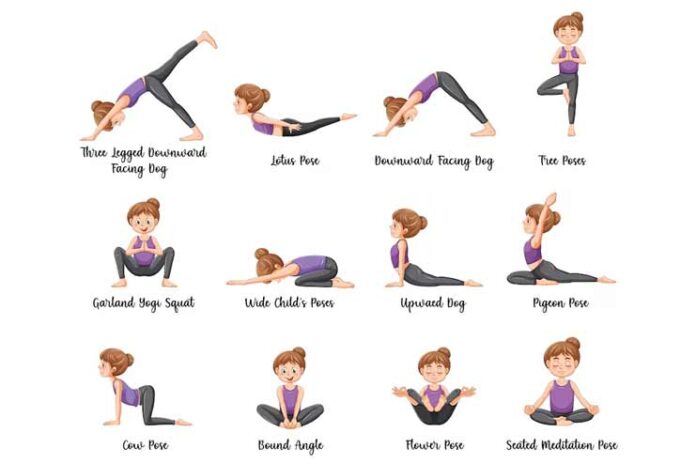Affiliate Disclaimer
Some links in this article are affiliate links. We may earn a small commission if you make a purchase through these links, at no extra cost to you. We only recommend products we find useful to our readersA mid-week yoga flow can be a refreshing addition to the hustle and bustle of daily life. Plan your Wednesday wellness with yoga for stress relief and restore balance. This mid-week practice will alleviate stress, enhance mental clarity, and rejuvenate your body.
Yoga reduces anxiety, improves concentration, and elevates your mood. In addition, it enhances flexibility, builds muscle, and enables one to enjoy general wellness. It also improves flexibility, and strengthens muscles.
Warm-Up Sequence
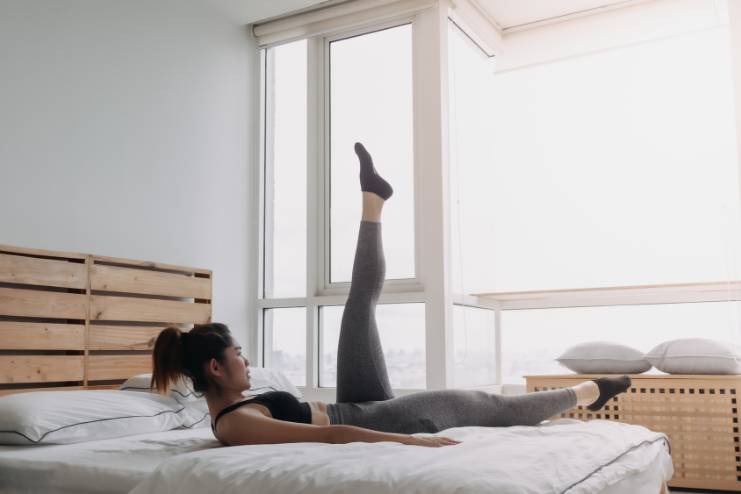
To prepare your body for a rejuvenating mid-week yoga flow, start with a yoga warm-up. Include these gentle stretches.
- Begin by lying on your back and performing pelvic tilts: press your lower back into the floor, tilting your pelvis toward your face, then release.
- Next, lift one leg at a time, stretching it toward the ceiling to engage your hamstrings and calves.
- Move into the Eye of the Needle pose by crossing one ankle over the opposite knee and gently drawing the knee toward your chest.
- For a seated warm-up, cross your legs into Easy Pose, and perform neck rolls to release tension.
- Follow with Eagle Arms to stretch the shoulders and finish with Easy Twists, turning gently to each side.
This warm-up will ease stiffness, improve flexibility, and prepare your body for a more effective yoga session.
Flow 1: Sun Salutations
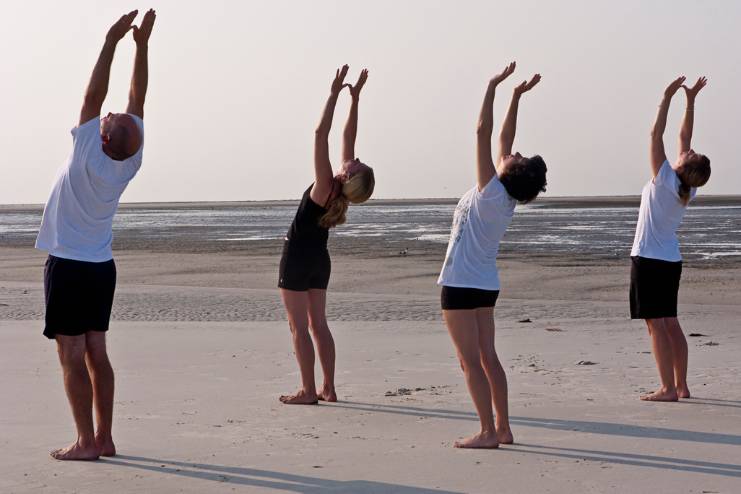
Sun Salutations (Surya Namaskar) are an invigorating sequence that warms up the entire body, increases flexibility, and boosts energy levels.
- To perform a basic Sun Salutation, start in Mountain Pose (Tadasana) with hands in prayer position.
- Inhale, raising your arms overhead into Raised Arms Pose (Urdhva Hastasana), and exhale into Standing Forward Bend (Uttanasana).
- Inhale to a Flat Back (Ardha Uttanasana), then exhale into Plank Pose.
- Lower down into Chaturanga Dandasana or knees, chest, and chin if needed.
- Inhale into Cobra Pose (Bhujangasana) or Upward-Facing Dog (Urdhva Mukha Svanasana), and exhale into Downward-Facing Dog (Adho Mukha Svanasana).
- Step or jump forward to a Standing Forward Bend, then inhale back to Raised Arms Pose and exhale to Mountain Pose.
- Repeat this sequence for 5-7 rounds to experience improved body flexibility, enhanced energy, and a balanced mind.
This yoga flow is excellent for integrating movement with breath, creating a harmonious start to your yoga practice.
Flow 2: Standing Poses
Warrior I – Virabhadrassana I
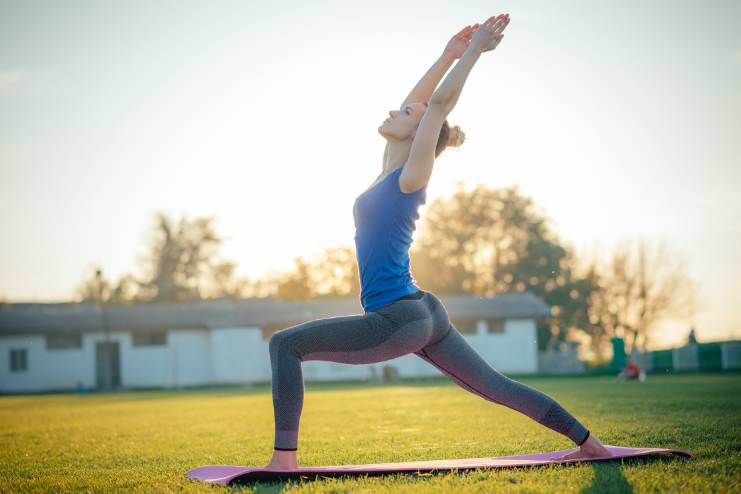
Begin your standing yoga sequence with Warrior I (Virabhadrasana I).
- From a standing position, step one foot back and bend the front knee to create a strong, stable base.
- Extend your arms overhead and gaze forward.
- This pose builds strength in the legs, core, and back while enhancing focus and determination. Hold for 5 breaths.
Warrior II – Virabhadrasana II
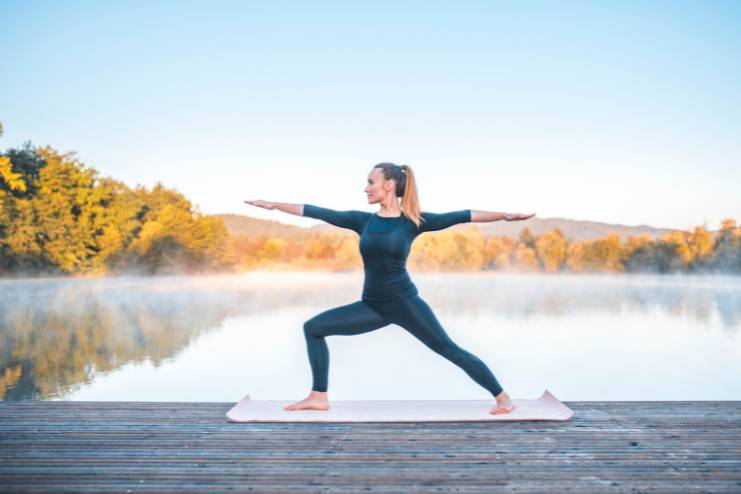
- Transition to Warrior II (Virabhadrasana II) by opening your hips and shoulders, extending your arms parallel to the floor, and gazing over your front hand.
- Warrior II amplifies strength in the legs, arms, and core while improving balance and stamina. Maintain the pose for 5 breaths.
Triangle Pose – Trikonasana
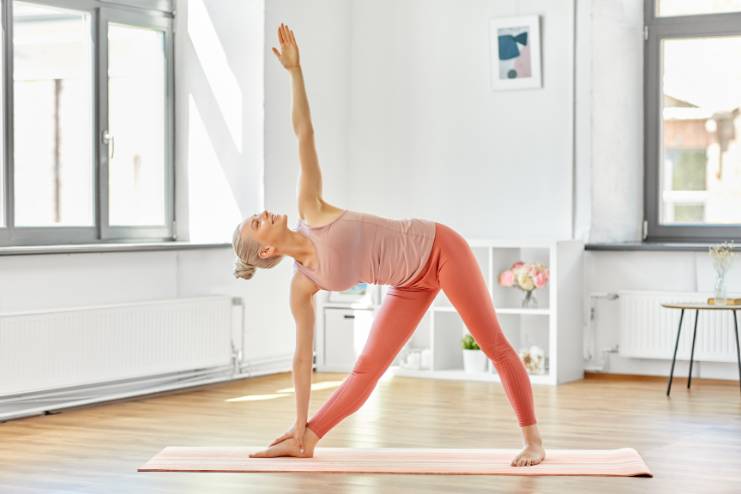
Move into Triangle Pose (Trikonasana) by straightening the front leg, reaching your front hand toward the floor or a block, and extending the opposite arm toward the sky.
This pose stretches the hips, hamstrings, and spine, while also fostering mental clarity and balance. Hold for 5 breaths.
The sequence of standing poses strengthens the body, enhances balance, and sharpens mental focus.
Flow 3: Balance Poses
Tree Pose – Vrksasana
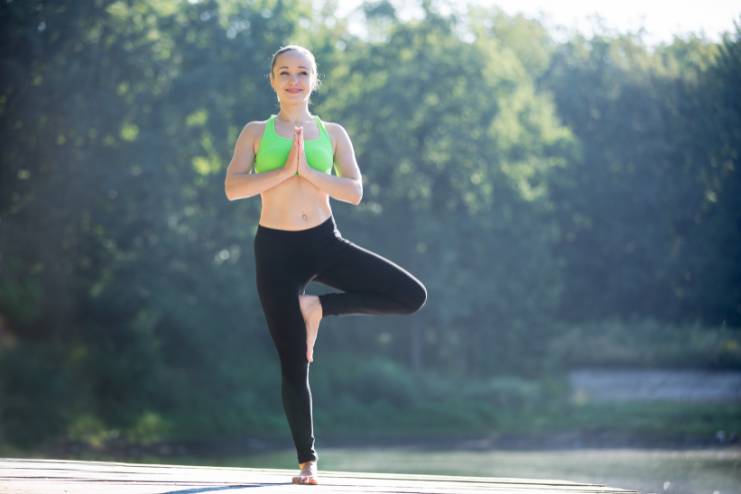
Incorporate these balance poses into your practice to enhance stability, concentration, and mental clarity.
- Tree Pose (Vrksasana) begins with standing on one leg.
- Lift the other foot and place it on your inner thigh or calf (avoid the knee).
- Press your foot into your leg and your leg into your foot.
- Bring your palms together at your chest or extend your arms overhead.
- Focus on a fixed point in front of you and hold for 5 breaths.
Eagle Pose – Garudasana
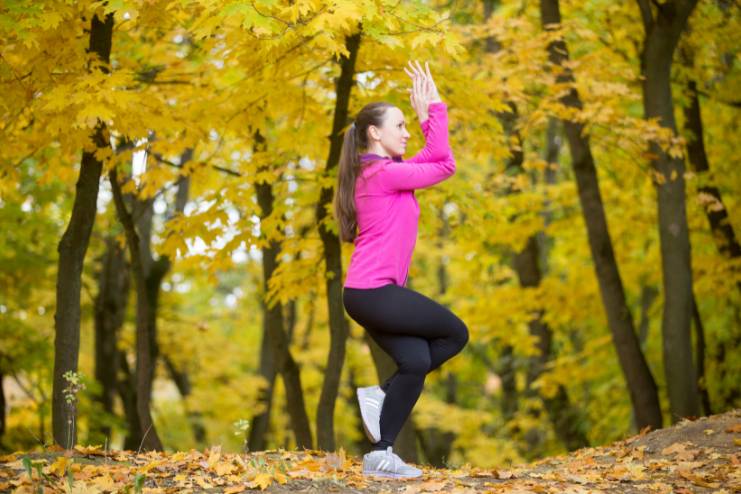
- Transition into Eagle Pose (Garudasana) by bending your knees slightly and lifting one leg to wrap it over the opposite leg.
- Hook your foot behind the calf if possible.
- Extend your arms forward, crossing one under the other, and press the palms together or touch the backs of your hands.
- Maintain balance and keep your gaze steady. Hold for 5 breaths.
Flow 4: Backbends and Heart Openers
Backbends and heart openers are essential for enhancing flexibility and relieving tension in the upper body. This flow features two key poses: Cobra Pose and Bridge Pose.
Cobra Pose – Bhujangasana
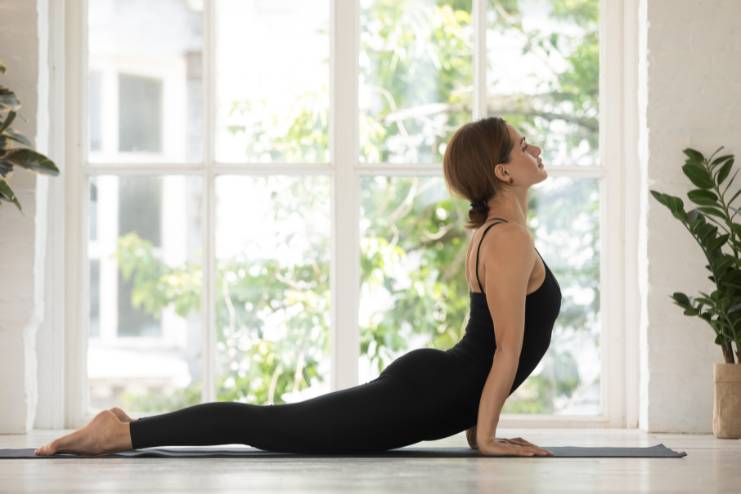
- Start by lying on your stomach with your legs extended and the tops of your feet pressing into the mat.
- Place your hands under your shoulders, elbows close to your body.
- Inhale and gently lift your chest off the ground, using your back muscles while keeping your elbows slightly bent.
- Engage your core and draw your shoulder blades back and down.
- Hold this pose for 5 breaths to open the chest and stretch the abdominal muscles, which helps in relieving upper back tension.
Bridge Pose – Setu Bandhasana
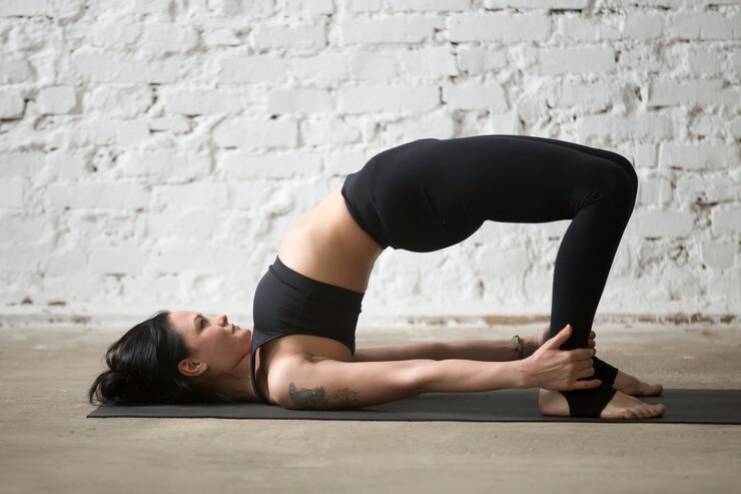
- Begin by lying on your back with your knees bent and feet hip-width apart, close to your buttocks.
- Press your feet into the mat as you lift your hips toward the ceiling, rolling your spine off the ground.
- Clasp your hands under your back and press your arms into the floor for support.
- Hold this pose for 5 breaths to open the chest and stretch the front of the body, which also aids in relieving lower back tension.
Flow 5: Seated and Forward Bends
Seated Forward Bend Pose – Paschimottanasana
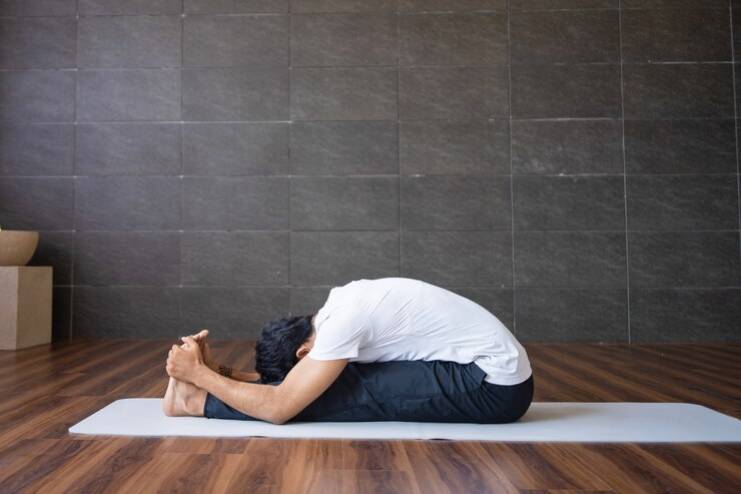
- Begin your flow with the Seated Forward Bend Pose (Paschimottanasana), where you sit with your legs extended straight in front of you.
- As you inhale, lengthen your spine, and as you exhale, hinge at the hips to fold forward.
- Reach for your feet or shins, maintaining a flat back to avoid straining the lower back.
- Hold the pose for 5 breaths, feeling the stretch along your hamstrings and lower back.
This pose is excellent for improving flexibility in the spine and calming the nervous system.
Butterfly Pose – Baddha Konasana A
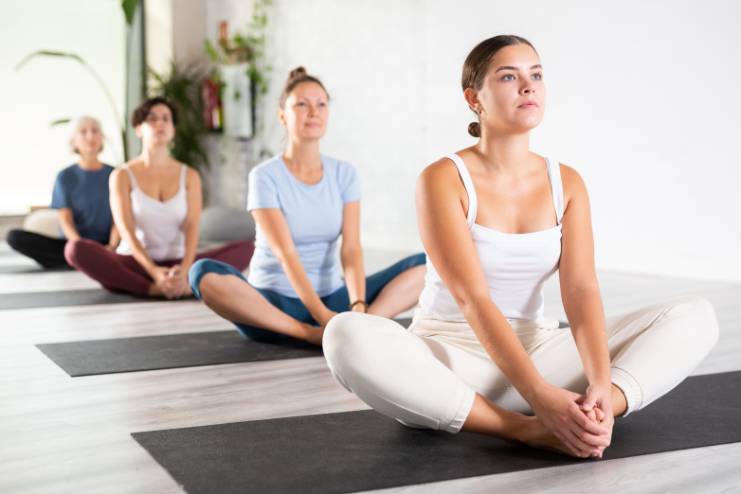
- Transition smoothly into Butterfly Pose (Baddha Konasana A).
- While seated, bring the soles of your feet together and gently press your knees towards the floor.
- Inhale to lengthen your spine and exhale to fold forward, keeping your chest open.
- Interlace your fingers around your feet or ankles for support.
- Hold for 5 breaths, focusing on the stretch in your inner thighs and lower back.
- This pose enhances flexibility, opens the hips, and encourages a sense of grounding and relaxation.
Both poses, held for 5 breaths each, help stretch the back, relieve tension, and calm the mind.
Flow 6: Twists
Seated Twist – Ardha Matsyendrasana
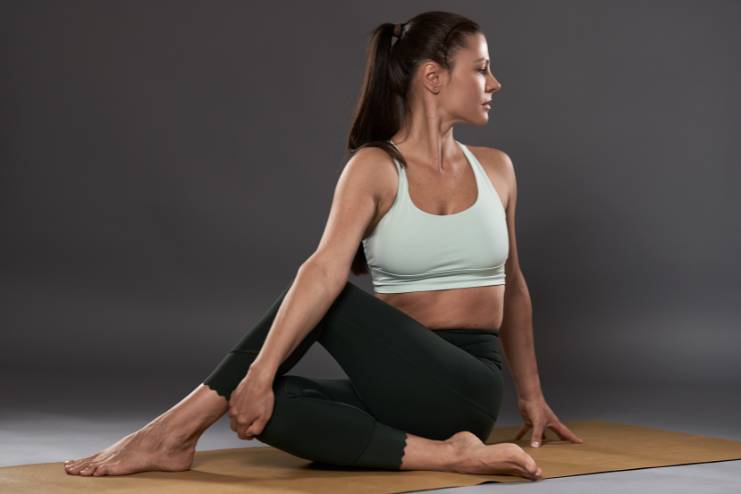
- Begin your yoga twist sequence with the Seated Twist (Ardha Matsyendrasana).
- Sit with your legs extended in front of you, then bend your right knee and place your right foot outside your left thigh.
- With an inhale, lengthen your spine, and on the exhale, twist your torso to the right, bringing your left elbow to the outside of your right knee.
- Hold for 5 breaths, feeling the gentle compression and detoxification in your abdominal organs.
- Switch sides and repeat the twist for balanced spinal flexibility and internal cleansing.
Reclined Twist – Supta Matsyendrasana II
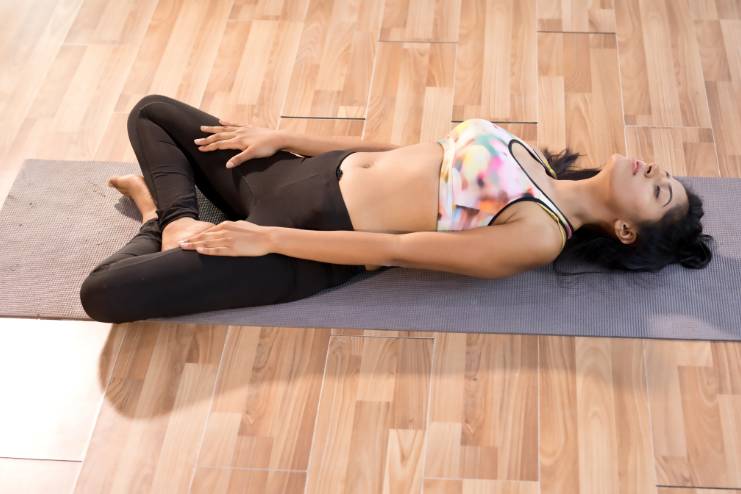
- Next, move into the Reclined Twist (Supta Matsyendrasana II).
- Lie on your back with your arms extended at shoulder height.
- Bend your knees and place your feet flat on the floor.
- On an exhale, gently drop your knees to the right while turning your head to the left.
- Hold for 5 breaths, allowing your spine to decompress and your digestive system to get a gentle massage.
- Repeat on the other side.
This pose enhances spinal flexibility, aids in detoxification, and provides a soothing stretch for the lower back.
Cool Down and Savasana
Happy Baby Pose – Ananda Balasana
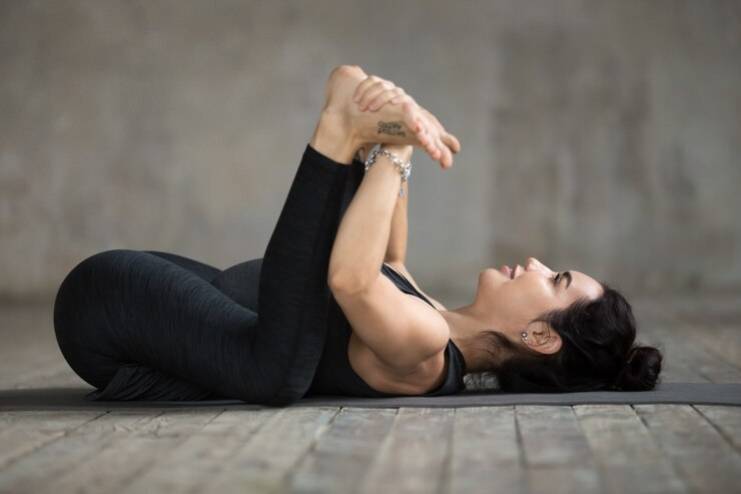
- To wind down your yoga session, start with a Gentle Cool Down.
- Begin by transitioning into Happy Baby Pose (Ananda Balasana) to release tension in the lower back and hips.
- Lie on your back, grab the outside edges of your feet, and gently pull your knees towards your armpits.
- Hold for 5 breaths, feeling a soothing stretch in the hips and lower spine.
Wind Release Pose – Pavanamuktasana
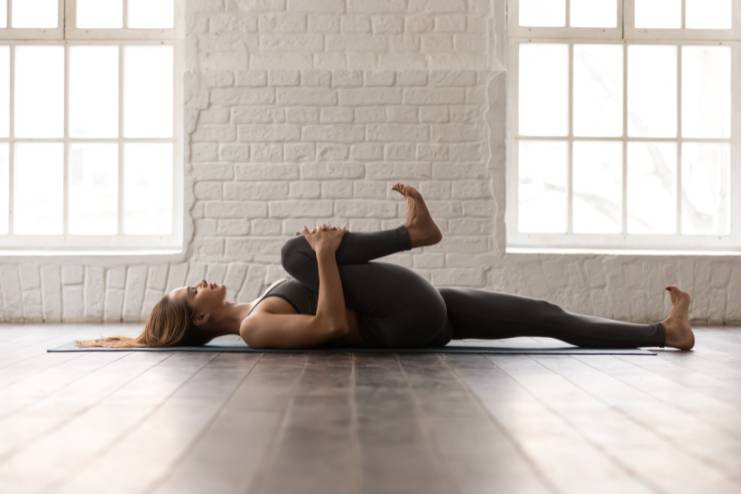
- Next, move into Wind Release Pose (Pavanamuktasana).
- Hug your knees towards your chest, gently rocking side to side.
- This pose helps release any remaining tension in your lower back and aids digestion.
- Hold for 5 breaths.
Supine Spinal Twist Pose II – Supta Matsyendrasana II
- From here, transition to Supine Spinal Twist Pose II (Supta Matsyendrasana II).
- With your arms extended and knees bent, gently drop your knees to one side while turning your head to the opposite side.
- Hold for 5 breaths on each side to further enhance spinal flexibility and detoxification.
Savasana – Corpse Pose
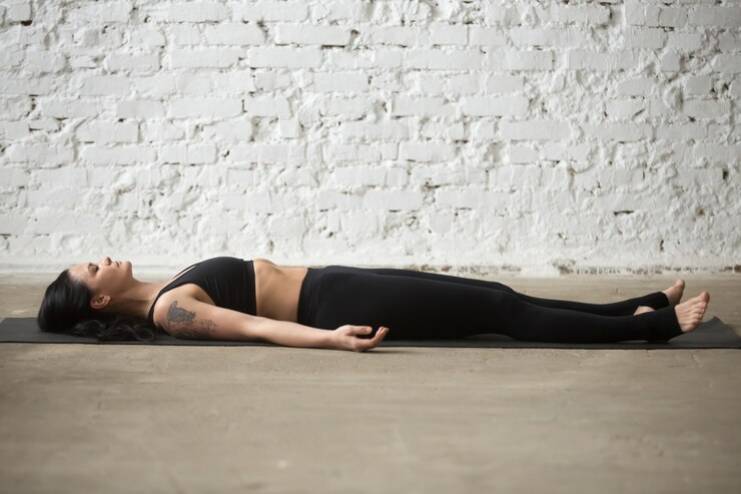
- Finish with Savasana (Corpse Pose) for complete relaxation.
- Lie on your back, arms at your sides, and legs extended comfortably.
- Close your eyes and focus on your breath.
- Hold this restorative pose for 5-10 minutes, allowing your body and mind to fully relax and absorb the benefits of your practice.
Savasana helps reduce stress, lower blood pressure, and rejuvenate your entire being.
Conclusion
Incorporating a mid-week yoga practice into your wellness routine offers numerous benefits for body and mind. It provides a rejuvenating pause that enhances physical flexibility, reduces stress, and promotes mental clarity. A mid-week session is a powerful tool for maintaining balance, preventing burnout, and supporting overall wellness. Regular practice helps manage stress, improve posture, and boost energy levels, ensuring that you navigate the rest of your week with greater ease and resilience.
References
- https://www.verywellfit.com/how-to-warm-up-for-yoga-3567192
- https://www.verywellfit.com/illustrated-stepbystep-sun-salutation-3567187
- https://www.tummee.com/yoga-poses/warrior-pose-i
- https://www.tummee.com/yoga-poses/warrior-pose-ii
- https://www.tummee.com/yoga-poses/triangle-pose
- https://www.tummee.com/yoga-poses/tree-pose
- https://www.tummee.com/yoga-poses/eagle-pose
- https://www.tummee.com/yoga-poses/cobra-pose
- https://www.tummee.com/yoga-poses/bridge-pose
- https://www.tummee.com/yoga-poses/seated-forward-bend-pose
- https://www.tummee.com/yoga-poses/butterfly-pose-a
- https://www.tummee.com/yoga-poses/sage-marichi-pose-c
- https://www.tummee.com/yoga-poses/reclined-twist
- https://www.tummee.com/yoga-poses/corpse-pose
In this Article
















